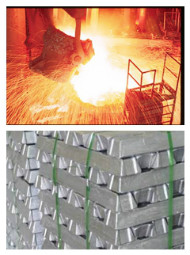 Nickel is recovered through extractive metallurgy: it is extracted from its ores by conventional roasting and reduction processes that yield a metal of greater than 75% purity. In many stainless steel applications, 75% pure nickel can be used without further purification, depending on the composition of the impurities.
Nickel is recovered through extractive metallurgy: it is extracted from its ores by conventional roasting and reduction processes that yield a metal of greater than 75% purity. In many stainless steel applications, 75% pure nickel can be used without further purification, depending on the composition of the impurities.- Most sulfide ores have traditionally been processed using pyrometallurgical techniques to produce a matte for further refining. Recent advances in hydrometallurgical techniques have resulted in significant nickel purification using these processes. Most sulfide deposits have traditionally been processed by concentration through a froth flotation process followed by pyrometallurgical extraction. In hydrometallurgical processes, nickel sulfide ores undergo flotation (differential flotation if Ni/Fe ratio is too low) and then smelted. After producing the nickel matte, further processing is done via the Sherritt-Gordon process. First, copper is removed by adding hydrogen sulfide, leaving a concentrate of only cobalt and nickel. Then, solvent extraction is used to separate the cobalt and nickel, with the final nickel concentration greater than 99%.
- Electrorefining
- A second common form of further refining involves the leaching of the metal matte into a nickel salt solution, followed by the electro-winning of the nickel from solution by plating it onto a cathode as electrolytic nickel.
- Mond process
 Purification of nickel oxides to obtain the purest metal is performed via the Mond process, which increases the nickel concentrate to greater than 99.99% purity. This process was patented by Ludwig Mond and has been in industrial use since before the beginning of the 20th century. In the process, nickel is reacted with carbon monoxide at around 40–80 °C to form nickel carbonyl in the presence of a sulfur catalyst. Iron gives iron pentacarbonyl, too, but this reaction is slow. If necessary, the nickel may be separated by distillation. Dicobalt octacarbonyl is also formed in nickel distillation as a by-product, but it decomposes to tetracobalt dodecacarbonyl at the reaction temperature to give a non-volatile solid.
Purification of nickel oxides to obtain the purest metal is performed via the Mond process, which increases the nickel concentrate to greater than 99.99% purity. This process was patented by Ludwig Mond and has been in industrial use since before the beginning of the 20th century. In the process, nickel is reacted with carbon monoxide at around 40–80 °C to form nickel carbonyl in the presence of a sulfur catalyst. Iron gives iron pentacarbonyl, too, but this reaction is slow. If necessary, the nickel may be separated by distillation. Dicobalt octacarbonyl is also formed in nickel distillation as a by-product, but it decomposes to tetracobalt dodecacarbonyl at the reaction temperature to give a non-volatile solid.- Nickel is re-obtained from the nickel carbonyl by one of two processes. It may be passed through a large chamber at high temperatures in which tens of thousands of nickel spheres, called pellets, are constantly stirred. It then decomposes, depositing pure nickel onto the nickel spheres. Alternatively, the nickel carbonyl may be decomposed in a smaller chamber at 230 °C to create a fine nickel powder. The resultant carbon monoxide is re-circulated and reused through the process. The highly pure nickel produced by this process is known as "carbonyl nickel".
- Source: Nickel-Wikipedia
- The high temperature (~250°C) acid pressure leaching of nickeliferous laterite ore has been practised commercially since the late 1950's. The acid pressure leach solution is treated using hydrogen sulphide to produce a high grade sulphide containing at least 50% nickel. This mixed sulphide is then pressure leached to give a high purity concentrated nickel-cobalt solution, suitable for solvent extraction to separate the valuable metals. The nickel and cobalt are separately reduced to metal products.
- The flow-sheet below shows the unit operations used in the process.
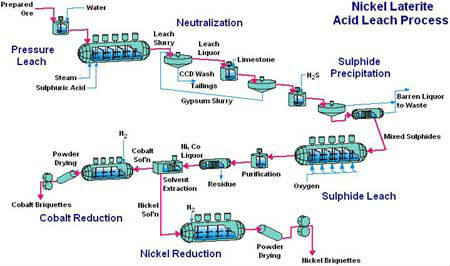
- Source: Acid Leach Process-METMOC
- The main source of the world's nickel is from copper-nickel sulphide ores with those mined at Sudbury, Ontario being by far the most extensive. The principle nickel sulphide is pentlandite (NiFeS2), which is usually associated with chalcopyrite and iron sulphides. International Nickel (INCO) and Sherritt Gordon use a bulk Cu/Ni float pictured below, followed by selective flotation of the two elements into separate concentrates. Other Canadian producers leave separation to the smelters.
- Flotation of a Copper/Nickel Ore Containing Pyrrhotite is as follows:
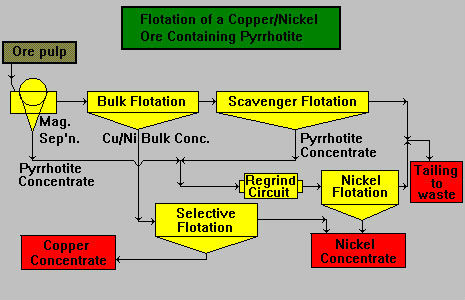
- Generalized Flowsheet of the INCO Matte Separation Process is as follows:

- Source: http://www.jmeech.mining.ubc.ca/MINE290/proces/nickel.php
- Outotec® Nickel Flash Smelting Process is a benchmark nickel-smelting method and a clear global leader in the world’s primary nickel production from sulfide raw materials. Efficiency and improved environmental and in-plant hygiene have been the guiding principles in developing the process.
- Process overview
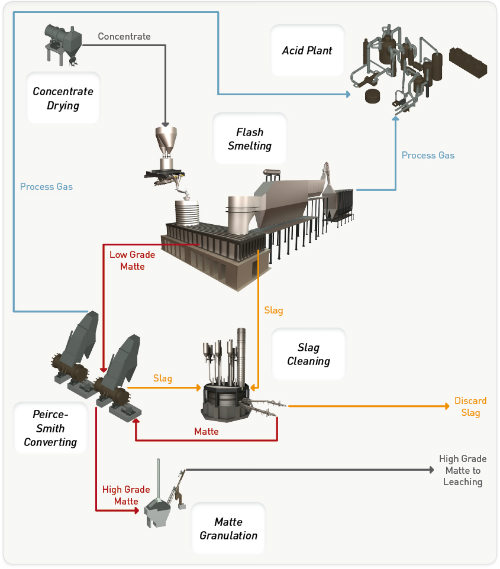
- Source: http://www.outotec.com/en/About-us/Our-technologies/Smelting/Nickel-flash-smelting-/
- Flash smelting
- Flash smelting (Finnish: Liekkisulatus) is a smelting process for sulfur-containing ores including chalcopyrite. The process was developed by Outokumpu in Finland and first applied at the Harjavalta plant in 1949 for smelting copper ore. It has also been adapted for nickel and lead production.
- A second flash smelting system was developed by the International Nickel Company ('INCO') and has a different concentrate feed design compared to the Outokumpu flash furnace. The Inco flash furnace has end-wall concentrate injection burners and a central waste gas off-take, while the Outokumpu flash furnace has a water-cooled reaction shaft at one end of the vessel and a waste gas off-take at the other end. While the INCO flash furnace at Sudbury was the first commercial use of oxygen flash smelting, fewer smelters use the INCO flash furnace than the Outokumpu flash furnace.
The reactions in the flash smelting furnaces produce copper matte, iron oxides and sulfur dioxide. The reacted particles fall into a bath at the bottom of the furnace, where the iron oxides react with fluxes, such as silica and limestone, to form a slag.
- Outotec, formerly the technology division on Outokumpu now holds Outokumpu's patents to the technology and licenses it worldwide. (INCO was acquired by Brazil's Vale in 2006.)
- Source: Flash smelting-WIKIPEDIA
- The Niihama Nickel Refinery is the only refinery that produces electrolytic nickel and electrolytic cobalt in Japan. The Niihama Nickel Refinery started production of electrolytic nickel in 1939. Since that time, it has undergone 2 major production changes, and now produces electrolytic nickel using the MCLE (Matte Chlorine Leach Electrowinning) method. This MCLE method process is highly evaluated as an excellent industrial manufacturing technology, making the refinery highly efficient even from a worldwide standard.
- Raw materials
- Nickel matte with a 70% nickel grade, procured from mines and smelters that we have a stake in, and mixed sulfide with a 60% nickel grade produced in Coral Bay, using the HPAL (High Pressure Acid Leach) process is used as raw material.
- Production Process of Electrolytic Nickel
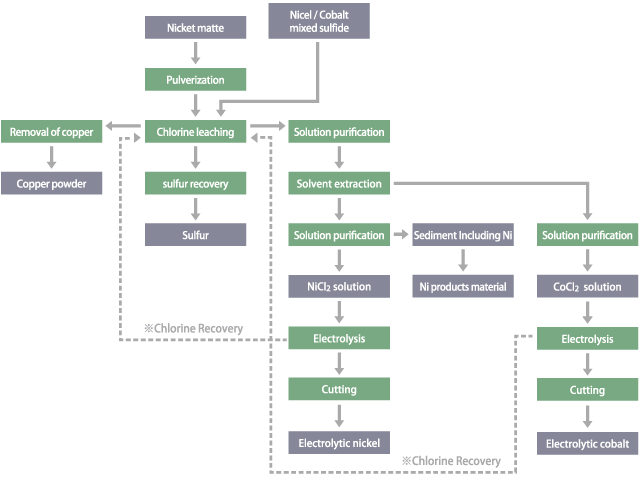
- Source: http://www.smm.co.jp/E/business/refining/domestic/nickel/kyoten.html
-
About us
Contact us
Make a suggestion
- Metalpedia is a non-profit website, aiming to broaden metal knowledge and provide extensive reference database to users. It provides users reliable information and knowledge to the greatest extent. If there is any copyright violation, please notify us through our contact details to delete such infringement content promptly.
 Nickel is recovered through extractive metallurgy: it is extracted from its ores by conventional roasting and reduction processes that yield a metal of greater than 75% purity. In many stainless steel applications, 75% pure nickel can be used without further purification, depending on the composition of the impurities.
Nickel is recovered through extractive metallurgy: it is extracted from its ores by conventional roasting and reduction processes that yield a metal of greater than 75% purity. In many stainless steel applications, 75% pure nickel can be used without further purification, depending on the composition of the impurities. Purification of nickel oxides to obtain the purest metal is performed via the Mond process, which increases the nickel concentrate to greater than 99.99% purity. This process was patented by Ludwig Mond and has been in industrial use since before the beginning of the 20th century. In the process, nickel is reacted with carbon monoxide at around 40–80 °C to form nickel carbonyl in the presence of a sulfur catalyst. Iron gives iron pentacarbonyl, too, but this reaction is slow. If necessary, the nickel may be separated by distillation. Dicobalt octacarbonyl is also formed in nickel distillation as a by-product, but it decomposes to tetracobalt dodecacarbonyl at the reaction temperature to give a non-volatile solid.
Purification of nickel oxides to obtain the purest metal is performed via the Mond process, which increases the nickel concentrate to greater than 99.99% purity. This process was patented by Ludwig Mond and has been in industrial use since before the beginning of the 20th century. In the process, nickel is reacted with carbon monoxide at around 40–80 °C to form nickel carbonyl in the presence of a sulfur catalyst. Iron gives iron pentacarbonyl, too, but this reaction is slow. If necessary, the nickel may be separated by distillation. Dicobalt octacarbonyl is also formed in nickel distillation as a by-product, but it decomposes to tetracobalt dodecacarbonyl at the reaction temperature to give a non-volatile solid.




